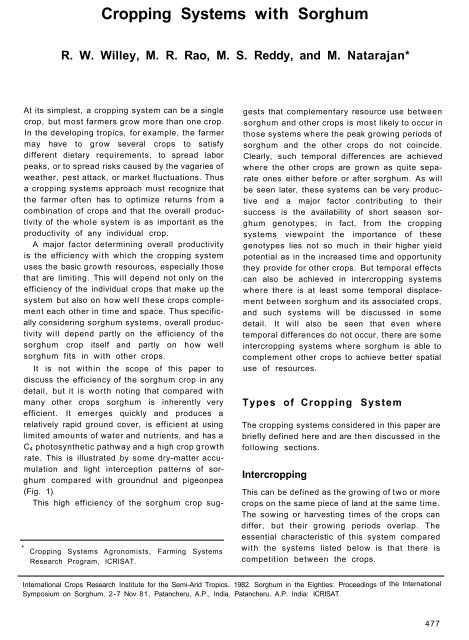RA 00048.pdf - OAR@ICRISAT
RA 00048.pdf - OAR@ICRISAT
RA 00048.pdf - OAR@ICRISAT
You also want an ePaper? Increase the reach of your titles
YUMPU automatically turns print PDFs into web optimized ePapers that Google loves.
Cropping Systems with Sorghum<br />
R. W. Willey, M. R. Rao, M. S. Reddy, and M. Natarajan*<br />
At its simplest, a cropping system can be a single<br />
crop, but most farmers grow more than one crop.<br />
In the developing tropics, for example, the farmer<br />
may have to grow several crops to satisfy<br />
different dietary requirements, to spread labor<br />
peaks, or to spread risks caused by the vagaries of<br />
weather, pest attack, or market fluctuations. Thus<br />
a cropping systems approach must recognize that<br />
the farmer often has to optimize returns from a<br />
combination of crops and that the overall productivity<br />
of the whole system is as important as the<br />
productivity of any individual crop.<br />
A major factor determining overall productivity<br />
is the efficiency with which the cropping system<br />
uses the basic growth resources, especially those<br />
that are limiting. This will depend not only on the<br />
efficiency of the individual crops that make up the<br />
system but also on how well these crops complement<br />
each other in time and space. Thus specifically<br />
considering sorghum systems, overall productivity<br />
will depend partly on the efficiency of the<br />
sorghum crop itself and partly on how well<br />
sorghum fits in with other crops.<br />
It is not within the scope of this paper to<br />
discuss the efficiency of the sorghum crop in any<br />
detail, but it is worth noting that compared with<br />
many other crops sorghum is inherently very<br />
efficient. It emerges quickly and produces a<br />
relatively rapid ground cover, is efficient at using<br />
limited amounts of water and nutrients, and has a<br />
C 4 photosynthetic pathway and a high crop growth<br />
rate. This is illustrated by some dry-matter accumulation<br />
and light interception patterns of sorghum<br />
compared with groundnut and pigeonpea<br />
(Fig. 1).<br />
This high efficiency of the sorghum crop sug-<br />
*<br />
Cropping Systems Agronomists, Farming Systems<br />
Research Program, ICRISAT.<br />
gests that complementary resource use between<br />
sorghum and other crops is most likely to occur in<br />
those systems where the peak growing periods of<br />
sorghum and the other crops do not coincide.<br />
Clearly, such temporal differences are achieved<br />
where the other crops are grown as quite separate<br />
ones either before or after sorghum. As will<br />
be seen later, these systems can be very productive<br />
and a major factor contributing to their<br />
success is the availability of short season sorghum<br />
genotypes; in fact, from the cropping<br />
systems viewpoint the importance of these<br />
genotypes lies not so much in their higher yield<br />
potential as in the increased time and opportunity<br />
they provide for other crops. But temporal effects<br />
can also be achieved in intercropping systems<br />
where there is at least some temporal displacement<br />
between sorghum and its associated crops,<br />
and such systems will be discussed in some<br />
detail. It will also be seen that even where<br />
temporal differences do not occur, there are some<br />
intercropping systems where sorghum is able to<br />
complement other crops to achieve better spatial<br />
use of resources.<br />
Types of Cropping System<br />
The cropping systems considered in this paper are<br />
briefly defined here and are then discussed in the<br />
following sections.<br />
Intercropping<br />
This can be defined as the growing of two or more<br />
crops on the same piece of land at the same time.<br />
The sowing or harvesting times of the crops can<br />
differ, but their growing periods overlap. The<br />
essential characteristic of this system compared<br />
with the systems listed below is that there is<br />
competition between the crops.<br />
International Crops Research Institute for the Semi-Arid Tropics. 1982. Sorghum in the Eighties: Proceedings<br />
Symposium on Sorghum, 2-7 Nov 81, Patancheru, A.P., India. Patancheru, A.P. India: ICRISAT.<br />
of the International<br />
477

















